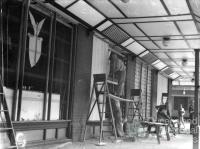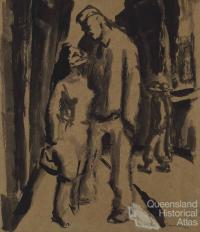- Home
- Quintessential Queensland
- Distinctiveness
- Perceptions
- Perceptions: how people understand the landscape
- From runs to closer settlement
- Geological survey of Queensland
- Mapping a new colony, 1860-80
- Mapping the Torres Strait: from TI to Magani Malu and Zenadh Kes
- Order in Paradise: a colonial gold field
- Queensland atlas, 1865
- Queensland mapping since 1900
- Queensland: the slogan state
- Rainforests of North Queensland
- Walkabout
- Queenslanders
- Queenslanders: people in the landscape
- Aboriginal heroes: episodes in the colonial landscape
- Australian South Sea Islanders
- Cane fields and solidarity in the multiethnic north
- Chinatowns
- Colonial immigration to Queensland
- Greek Cafés in the landscape of Queensland
- Hispanics and human rights in Queensland’s public spaces
- Italians in north Queensland
- Lebanese in rural Queensland
- Queensland clothing
- Queensland for ‘the best kind of population, primary producers’
- Too remote, too primitive and too expensive: Scandinavian settlers in colonial Queensland
- Distance
- Movement
- Movement: how people move through the landscape
- Air travel in Queensland
- Bicycling through Brisbane, 1896
- Cobb & Co
- Journey to Hayman Island, 1938
- Law and story-strings
- Mobile kids: children’s explorations of Cherbourg
- Movable heritage of North Queensland
- Passages to India: military linkages with Queensland
- The Queen in Queensland, 1954
- Transient Chinese in colonial Queensland
- Travelling times by rail
- Pathways
- Pathways: how things move through the landscape and where they are made
- Aboriginal dreaming paths and trading ways
- Chinese traders in the nineteenth century
- Introducing the cane toad
- Pituri bag
- Press and the media
- Radio in Queensland
- Red Cross Society and World War I in Queensland
- The telephone in Queensland
- Where did the trams go?
- ‘A little bit of love for me and a murder for my old man’: the Queensland Bush Book Club
- Movement
- Division
- Separation
- Separation: divisions in the landscape
- Asylums in the landscape
- Brisbane River
- Changing landscape of radicalism
- Civil government boundaries
- Convict Brisbane
- Dividing Queensland - Pauline Hanson’s One Nation Party
- High water mark: the shifting electoral landscape 2001-12
- Hospitals in the landscape
- Indigenous health
- Palm Island
- Secession movements
- Separate spheres: gender and dress codes
- Separating land, separating culture
- Stone walls do a prison make: law on the landscape
- The 1967 Referendum – the State comes together?
- Utopian communities
- Whiteness in the tropics
- Conflict
- Conflict: how people contest the landscape
- A tale of two elections – One Nation and political protest
- Battle of Brisbane – Australian masculinity under threat
- Dangerous spaces - youth politics in Brisbane, 1960s-70s
- Fortress Queensland 1942-45
- Grassy hills: colonial defence and coastal forts
- Great Shearers’ Strike of 1891
- Iwasaki project
- Johannes Bjelke-Petersen: straddling a barbed wire fence
- Mount Etna: Queensland's longest environmental conflict
- Native Police
- Skyrail Cairns (Research notes)
- Staunch but conservative – the trade union movement in Rockhampton
- The Chinese question
- Thomas Wentworth Wills and Cullin-la-ringo Station
- Separation
- Dreaming
- Imagination
- Imagination: how people have imagined Queensland
- Brisbane River and Moreton Bay: Thomas Welsby
- Changing views of the Glasshouse Mountains
- Imagining Queensland in film and television production
- Jacaranda
- Literary mapping of Brisbane in the 1990s
- Looking at Mount Coot-tha
- Mapping the Macqueen farm
- Mapping the mythic: Hugh Sawrey's ‘outback’
- People’s Republic of Woodford
- Poinsettia city: Brisbane’s flower
- The Pineapple Girl
- The writers of Tamborine Mountain
- Vance and Nettie Palmer
- Memory
- Memory: how people remember the landscape
- Anna Wickham: the memory of a moment
- Berajondo and Mill Point: remembering place and landscape
- Cemeteries in the landscape
- Landscapes of memory: Tjapukai Dance Theatre and Laura Festival
- Monuments and memory: T.J. Byrnes and T.J. Ryan
- Out where the dead towns lie
- Queensland in miniature: the Brisbane Exhibition
- Roadside ++++ memorials
- Shipwrecks as graves
- The Dame in the tropics: Nellie Melba
- Tinnenburra
- Vanished heritage
- War memorials
- Curiosity
- Curiosity: knowledge through the landscape
- A playground for science: Great Barrier Reef
- Duboisia hopwoodii: a colonial curiosity
- Great Artesian Basin: water from deeper down
- In search of Landsborough
- James Cook’s hundred days in Queensland
- Mutual curiosity – Aboriginal people and explorers
- Queensland Acclimatisation Society
- Queensland’s own sea monster: a curious tale of loss and regret
- St Lucia: degrees of landscape
- Townsville’s Mount St John Zoo
- Imagination
- Development
- Exploitation
- Transformation
- Transformation: how the landscape has changed and been modified
- Cultivation
- Empire and agribusiness: the Australian Mercantile Land and Finance Company
- Gold
- Kill, cure, or strangle: Atherton Tablelands
- National parks in Queensland
- Pastoralism 1860s–1915
- Prickly pear
- Repurchasing estates: the transformation of Durundur
- Soil
- Sugar
- Sunshine Coast
- The Brigalow
- Walter Reid Cultural Centre, Rockhampton: back again
- Survival
- Survival: how the landscape impacts on people
- Brisbane floods: 1893 to the summer of sorrow
- City of the Damned: how the media embraced the Brisbane floods
- Depression era
- Did Clem Jones save Brisbane from flood?
- Droughts and floods and rail
- Missions and reserves
- Queensland British Food Corporation
- Rockhampton’s great flood of 1918
- Station homesteads
- Tropical cyclones
- Wreck of the Quetta
- Pleasure
- Pleasure: how people enjoy the landscape
- Bushwalking in Queensland
- Cherbourg that’s my home: celebrating landscape through song
- Creating rural attractions
- Festivals
- Queer pleasure: masculinity, male homosexuality and public space
- Railway refreshment rooms
- Regional cinema
- Schoolies week: a festival of misrule
- The sporting landscape
- Visiting the Great Barrier Reef
By:
Danielle Miller When thinking of the great battlefields of World War II it is Stalingrad’s rooftops, London’s skyline and the jungles of Burma that come to mind, not the sleepy 'big country town' of Brisbane. But it was on Brisbane's streets, between 26 and 28 November 1942, that a legendary battle occurred between American and Australian soldiers, fuelled by tension over access to Australian women. As Michael Sturma wrote in 1989, women themselves became ‘disputed territory’ as the latent hostilities of wartime boiled over.
From saviours to unwelcome interlopers
Fears of a Japanese invasion meant that General Douglas MacArthur’s American troops were welcomed on their arrival in Brisbane from early 1942. However a number of factors inflamed tensions between the two Allies. American servicemen had access to a range of resources outside the grasp of their Australian counterparts. The fact that the 'Battle of Brisbane' centred on the American canteen, located at the corner of Adelaide and Creek Street, highlights one source of conflict. American soldiers were paid more than Australian servicemen and had greater access to luxury goods. To make matters worse, Australian soldiers were not allowed to patronise the American Postal Exchange, or PX, while Americans were able to buy goods at the Australian canteen.
Conflict did not just centre on access to goods, but the impact this differential access was seen to have on relationships between soldiers and the women of Queensland. At the time it was believed that their greater access to material goods was a key factor in the success of Americans with the resident female population. Women’s own accounts, however, reveal that they were often attracted to American servicemen for other reasons, notably their often apparent genuine fondness for women. Even the official war historian, Gavin Long, notes (although not in an entirely critical way): ‘Australians have always treated their women a little worse than their dogs. Therefore the Americans who have usually been taught to respect women and have displayed some tenderness towards Australian women, have stolen most of the pretty girls.’ Long’s use of the word ‘stolen’ reinforces the view that women were seen as property – a situation that set the scene for conflict.
Access to women
It did not take long for concern to arise over the relationship between Australian women and American soldiers. In the first month after the arrival of the American forces newspaper articles began appearing questioning the behaviour of women fraternising with the newcomers. Such concern spread to Australian servicemen and was even used by the Japanese in their propaganda to undermine the morale of soldiers serving in Papua New Guinea. One Australian solider serving overseas stated in a letter to his wife ‘We know what’s going on in Australia, the Americans have got all the women’. As the implicit anger in this statement suggests, many Australian men felt aggrieved by the popularity of the Americans.
The Battle of Brisbane
Matters erupted into violence in the late afternoon of November 26, the American holiday of Thanksgiving. There had been earlier brawls in Albert Street, but as evening came on a trivial and isolated argument spiralled out of control, exacerbated by alcohol consumption. The opening clash broke out at the Australian canteen in Adelaide Street, after Australian soldiers, including decorated soldier, Gunner Edward Webster became involved in a dispute with an American and the American military police (MPs) stepped in. The Australians then sided with the soldier against the police as the argument turned physical. An Australian was hit by a baton and the American MPs were chased down Adelaide Street towards the PX.
With the military police barricaded inside the PX and calling for assistance, the situation escalated and at its peak involved several thousand Australians. Rocks and bricks were used as weapons, and during the melee Webster was killed by a shotgun fired by a military Private J. Grant, as the two fought for control of the weapon. Webster was not the only casualty. By the end of Thanksgiving night, seven other Australians had suffered buckshot wounds and at a minimum nine American soldiers, including Grant, were also hurt, one with a fractured skull. The incident was followed by a second wave of attacks on individual Americans, when 'Yanks' in the company of local women found themselves targets for attack, set upon and beaten by gangs of Australian servicemen.
Even though the initial riot broke out over the behaviour of American military police, there were deeper sources of tension fuelling the violence. The 'Battle of Brisbane', a legendary moment of drama on Queensland's World War II home front, was fuelled by competition for the attention of Australian women and the anger many Australian men felt at the American incursion into ‘their’ territory.
References and Further reading (Note):
Joan Beaumont, Australia’s war, 1939-45, Crows Nest, Allen & Unwin, 1996
References and Further reading (Note):
Libby Connors, Lynette Finch, Kay Saunders and Helen Taylor, Australia’s frontline: remembering the 1939-45 War, St Lucia, University of Queensland Press, 1992
References and Further reading (Note):
Raymond Evans and Jacqui Donegan, ‘Battle of Brisbane, 1942’, in Raymond Evans and Carole Ferrier (eds), Radical Brisbane: an unruly history, Carlton North, The Vulgar Press, 2004
References and Further reading (Note):
Michael Sturma, ‘Loving the alien: the underside of relations between American servicemen and Australian women in Queensland, 1942-1945’, Journal of Australian studies, 13, 1989
References and Further reading (Note):
Peter A. Thompson and Robert Macklin, The Battle of Brisbane: Australians and the Yanks at war, Sydney, ABC Books, 2000





